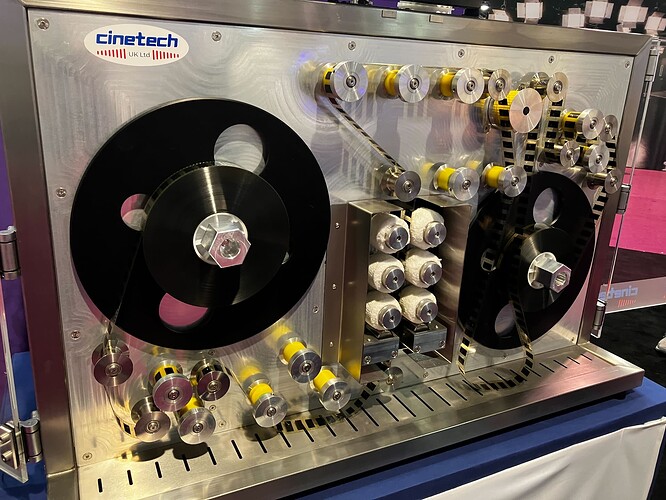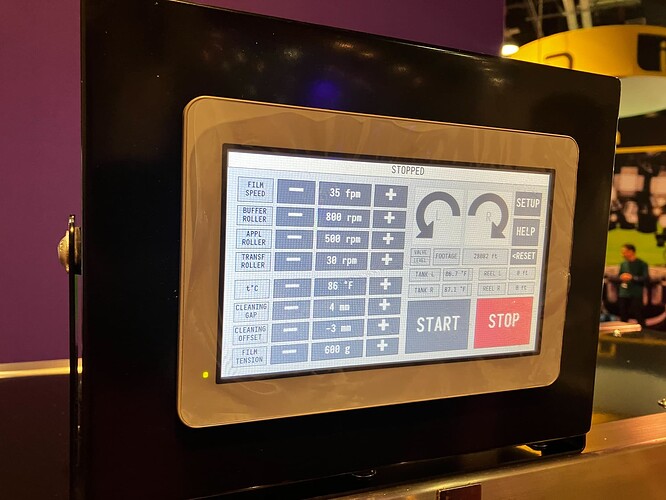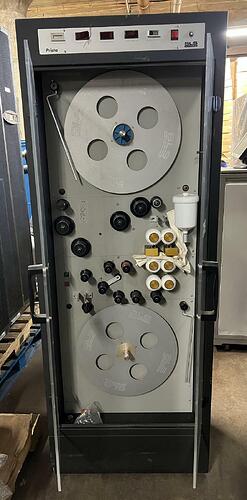At NAB for a couple days. The sales rep for Lasergraphics is now selling the Cinetech film cleaner. It’s an interesting machine:
(In this photo it’s not fully threaded because he was showing me something else. you can see the actual threading on their site: https://www.cinetech.uk/
There are a lot of rollers because they aren’t using a heated dryer box like the Lipsner-Smith cleaners use, so there needs to be more physical space for the cleaning solvent (Isopar-G: Naptha) to dry. They are showing it with a 16mm/35mm configuration, and this machine could do 8mm, but I suggested to them that they might consider an 8mm only model that’s much smaller. Does that seem like something people would be interested in, and at what price (bearing in mind the full size version is around $60k US).
What makes this different from the Lipsner-Smith is that it has a very small solvent reservoir (only a couple ounces), because it doesn’t use much in a given run. There is an option for a larger reservoir if you are doing a bunch of cleaning at once. There are no pumps or hoses, the solvent is gravity fed. There is no drying box, it dries inside the unit before it reaches the takeup reel. This machine runs a bit slower as a result. It is fully enclosed and has a 4" vent duct port on the top.
The controls are pretty interesting too, because you can control the lateral position of the buffer wheels, in order to concentrate cleaning on one side of the film or another. That is, if you know the emulsion is in a more delicate state, you could basically just clean the base side by adjusting the roller position.
Tension is handled with a simple 4-roller tension wheel assembly, and is user-adjustable. Inside everything is stepper based, and very simple, unlike the much more complex Lipsner-Smith machines. I like this a lot and we’re considering getting one.
4 Likes
I know someone who has one on order, yes they appear to be good value with the only downsides being they have an insane number of PTRs due to how it dries the solvent and they are very expensive (rebuilt ultrasonics I believe are about $20K-30K). That said, the fact it supports 8mm is a huge selling point and advantage, and Isopar-G is an excellent cleaning solvent. They clean in a similar way to the Prista - the little metal rollers at the bottom puts the solvent onto the cleaning buffers (the bottom pair) and then the next two ones buff off some of the solvent, and then it goes through a heap of PTRs that get it dry. Too many PTRs really, it would be better to use more buffer rollers IMHO, but I’m not an engineer.
The issue with PTRs is they can scratch film if film slips on them and there’s abrasive dirt, and by definition you have dirty film going into a cleaner, and to get really filthy dirty film clean you may need to put it through the cleaner multiple times (that’s true with Perc cleaners).
It’s more compact than a Prista which is absolutely massive and another major pro for the cleaner. You can see the cleaning buffers are similar to the Prista:
(Photo: eBay).
With the exception that film goes top-down through the Prista, and bottom-up through the Cinetech (hence why the metal rollers that apply the Isopar-G solvent to the cleaning buffers are at the top on the Prista and the bottom on the Cinetech).
Do these buffer rollers rotate in the same direction as the film, or in the opposite direction to scrub? If they rotate the same direction, are they moving at the same speed as the film or faster/slower, again to scrub?
I believe they move in the opposite direction. It wouldn’t make sense to go in the same direction as the film.
Our Lipsner Smith Excel 1100 has two sets of rollers: the first pair is the “wet” roller set, and the second are the dry rollers. The wet rollers are saturated in Isopropyl alcohol, the dry rollers are there to get most of that alcohol off before it moves into the drying box (which uses a warm air knife to evaporate the remaining alcohol before it moves into the final set of PTRs).
All the rollers rotate against the direction of the film in our machine.
1 Like
Could you put me in tough with the person who ordered the Hydra? Looking to get one and want some real world feedback.
Thanks!
find me on instagram if you can’t PM me here. @justin_lovell or my website www.framediscreet.com
Okay, I know very little about film cleaning, but I know plenty about machining. That back plate has been machined flat, using about a 10mm stepover, that’s what the subtle contouring around the various holes and rollers is from machining around and around and around. It may look cool, but it is a stupid waste machine time. I would get that plate blanchard ground before putting it the CNC machine to add what basically amounts to a bunch of holes. One method is an hour or two of machining, the other 5 or ten minutes.
To make an analogy, it’s like mowing your lawn with a tiny mower half a meter wide, or using a 100 meter wide mower in one pass. I guess it looks cool though.


